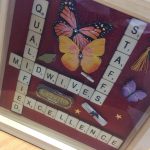One of our lovely 2nd year students recently gave the midwifery team a present. It was a physical birth register – the idea is that every time a student delivers a baby, they post a token into the slot at the top so it gives them a visual and tangible reminder of their progress in achieving the 40 births they have to manage in order to qualify as a midwife. Stacey explained that she regards our role as educators as being similar to that of a clinical midwife in that we help midwives to be born (sometimes kicking and screening).
The tokens with the register are shaped like butterflies and the symbolism is not lost on us. The first stage of the butterfly life cycle is the egg, with some butterflies if you look close enough you can see the caterpillar inside. This signifies the potential that we see in our new student midwives: their care, compassion and ability to evaluate and problem solve. The larva forms the 2nd stage, this is a short period of time where all they do is eat. This is like the first year of midwifery education: the students vociferously digest new knowledge and skills in order to be prepared for the increasing autonomy that the subsequent years bring. As the students enter the 2nd and 3rd year, they slowly metamorphosis and become recognisable as the midwife they will become (the pupa stage). Finally, they emerge with all the skills and knowledge needed to be registered midwives and similar to butterflies, they are expected to take on the role of adulthood straight away.
The midwifery journey to becoming an ‘adult butterfly’ is not an easy one. Our most senior cohort is flying away right now and their reflections are both painful and joyous in equal measure. They have all cried, laughed and despaired – birth is one of the most intense, emotional and life-changing moments in anyone’s life and it is therefore unsurprising that the students do get affected by the experience. During their time, they will have sat with a family quietly, letting them talk about what their stillborn baby could have been. They will have witnessed miracle births which medics told the family would never happen. They will have had sleepless nights over child protection issues and families living in extreme poverty. They have participated in emergencies where every instinct would have been to run screaming from the room – but they didn’t, they swallowed their fear and did the best they could do to help. They will have grappled with complex physics, chemistry and biology trying to equate the science with the art of midwifery. Most of all, however they will have really cared, this will have changed some of their political viewpoints and in doing so, made them question humanity. Our students did not know whether they helped with the birth of the next Adolph Hitler or the next Mother Theresa but they didn’t care. I know that each time they worked with families, they did so with warmth, professionalism and a real commitment to doing their best.
As I raise a toast to the newly metamorphosed adult butterflies, I hope that the eggs that are about to enter the larva stage this month become as bright and wonderful as the ones leaving us now.



Traci Hudson, Lead Midwife for Education/Course Leader, Traci.Hudson@staffs.ac.uk

